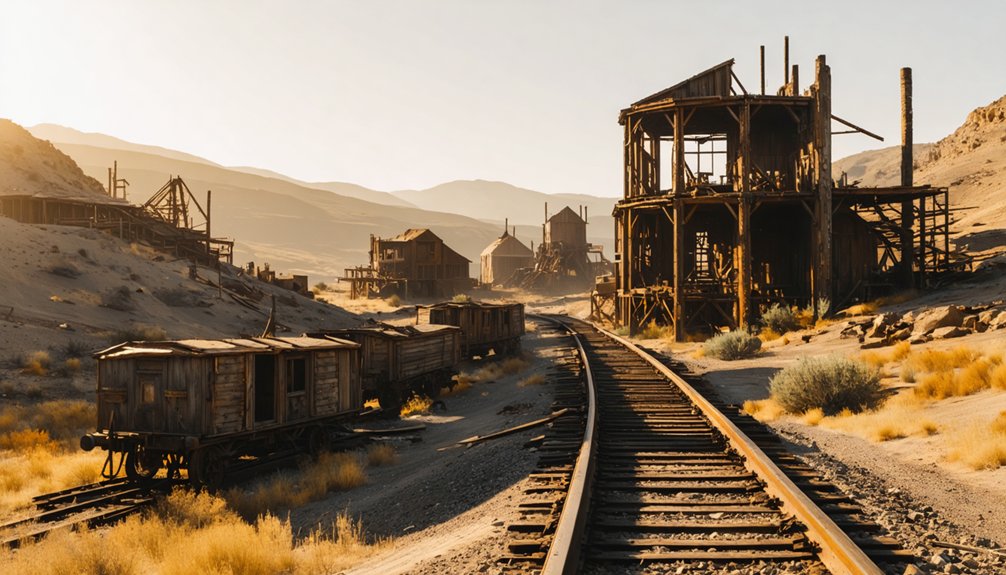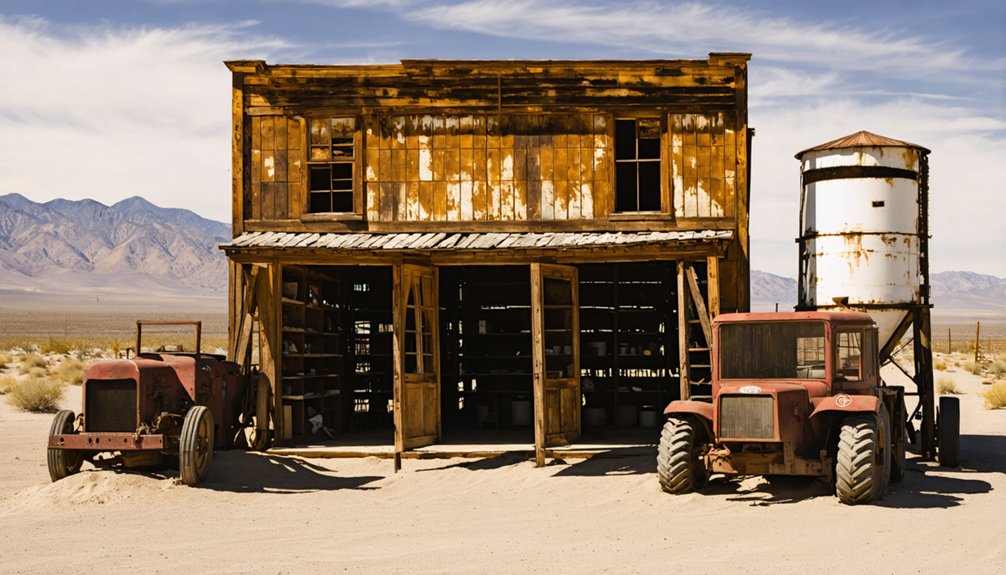You’ll find Barnes Settlement, a former gold mining town in El Dorado County, at 1,000 feet elevation where it flourished from 1894 to the 1920s. The Barnes-Eureka Mine anchored this desert community of 50-200 residents, who lived in wooden structures around communal wells. F.W. Barnes established both mining and agricultural ventures, including a 600-tree lemon grove. Today, you can explore scattered ruins, adobe foundations, and mining equipment that tell a compelling story of California’s gold rush era.
Key Takeaways
- Barnes Settlement was a late 19th-century gold mining community in El Dorado County, California, established around the Barnes-Eureka Mine before 1894.
- The settlement reached its peak after 1894 with 50-200 residents before declining around 1915 due to depleted gold deposits.
- F.W. Barnes established both mining operations and agricultural ventures, including a lemon grove producing 56,000 lemons annually by 1897.
- The settlement briefly incorporated as Barnes City in 1926 and hosted the Al Barnes Circus until 1927, when its departure triggered economic collapse.
- Today, the ghost town features scattered ruins, including adobe foundations, mining equipment, and abandoned wooden structures with original artifacts visible inside.
The Rise of a Desert Mining Camp
While California’s Gold Rush era spawned countless mining settlements, Barnes Settlement emerged as a notable desert mining camp in El Dorado County during the late 19th century.
You’ll find it perched at 1,000 feet elevation, where prospectors first discovered the Barnes-Eureka Mine before 1894.
The settlement’s miners faced intense desert challenges as they extracted gold from both gravel and hard rock deposits.
Desert miners battled harsh conditions while pursuing gold treasures hidden in gravel beds and solid rock formations.
They’d adopt advanced mining techniques learned from the Comstock Lode, sinking deeper shafts that required sophisticated ventilation systems and robust hoisting equipment. The mine operations required skilled mining engineers to design and implement efficient extraction methods.
The mine’s 40-acre expanse saw intermittent operation through 1936, with workers using heavy timber to support unstable underground passages.
Water scarcity constantly tested their resolve, forcing them to develop innovative solutions for survival and mineral extraction in this unforgiving terrain, much like the settlers who abandoned their farms during the devastating drought of 1894-1904 in Antelope Valley.
Life in Barnes Settlement
Beyond the technical aspects of mining operations, daily life in Barnes Settlement painted a stark picture of frontier existence. You’d find a largely male population of 50-200 residents living in basic wooden structures, relying on communal wells and outdoor privies.
Community dynamics revolved around the saloon and general store, where miners would gather after grueling 12-hour shifts. Daily routines centered on survival, with residents supplementing their mining work through hunting, fishing, and trading. The town’s fortunes followed the typical boom and bust cycle that characterized most California mining settlements. Like many settlements in San Bernardino County, the community struggled to maintain its population as resources dwindled.
You’d witness a diverse mix of European immigrants, Chinese laborers, and Native Americans, each carving out their roles in the settlement. Entertainment came through music, gambling, and storytelling, while the community handled disputes informally.
Despite harsh conditions, including limited medical care and frequent natural disasters, residents forged bonds through shared hardships and mutual aid.
Mining Operations and Economic Development

During the mid-to-late 19th century California mining boom, Barnes Settlement emerged as a significant gold mining hub with operations later expanding to include silver, copper, and minor deposits of lead and zinc.
The harsh desert climate posed unique challenges for mineral extraction, requiring innovative water storage solutions and frequent equipment maintenance.
Despite these obstacles, mining operations provided essential economic sustainability during the drought and Depression years of 1894-1930s. Several mining claims were challenged through dummy entry-man schemes that threatened local operations.
Through persistent economic hardships, the mines remained a crucial lifeline sustaining local communities across decades of drought and Depression.
A key development was the 350-foot inclined shaft that provided access to multiple mining levels.
Despite these obstacles, mining operations provided essential economic sustainability during the drought and Depression years of 1894-1930s.
You’ll find evidence of extensive infrastructure development, including expanded roads for ore shipment and ancillary industries like repair shops and processing facilities.
The settlement’s growth faced ongoing challenges from high operational costs, legal disputes over mineral rights, and supply chain disruptions.
Mining companies had to adapt continually, developing new strategies to maintain profitability amid fluctuating mineral prices and environmental hardships.
The People Behind the Settlement
The founding families of Barnes Settlement centered around two prominent figures: Franklin Wile (F.W.) Barnes, a Nebraska banker turned California agriculturalist, and his son Edward Young (E.Y.) Barnes.
F.W. Barnes established the settlement’s agricultural foundation by planting 600 lemon trees on his 9.32-acre property, which yielded 56,000 lemons annually by 1897. In 1897, Barnes & Son were shipping 75 to 100 boxes of lemons weekly to meet growing demand. Like General Mason’s report on Sutter’s Mill, news of the Barnes’ agricultural success attracted many settlers to the region.
The Barnes family’s ties to the community strengthened when E.Y. Barnes married Lulo Thorpe in 1895.
The Thorpe family, who owned property across Lamont Street, shared the Barnes’ commitment to citrus cultivation. This union led to F.W. Barnes transferring half his property to the newlyweds, including their home El Nido and several hundred lemon trees.
Both families’ proximity and shared agricultural interests created lasting bonds that shaped the settlement’s early development.
From Boom to Abandonment
You’ll find Barnes Settlement‘s rapid rise and fall mirrored in its short-lived incorporation as Barnes City in 1926, when the Al Barnes Circus made it their winter home.
The area originally housed the circus in a large circus tent near Venice Lagoon from 1914 to 1919, before moving to their permanent location.
Similar to the Los Angeles pueblo, the settlement initially attracted families seeking economic opportunities through entertainment and commerce.
The circus’s departure in 1927 triggered an immediate economic collapse, with hundreds of jobs lost and local businesses shuttering their doors.
What remains today is a quiet Los Angeles neighborhood, with virtually no trace of the vibrant circus community that once called this area home.
Mining’s Brief Glory Days
Barnes Settlement’s mining glory days emerged swiftly after 1894, when operations at the Barnes-Eureka Mine (also known as Greenstone Mine) spurred rapid development around its two 40-acre claims.
You’d have witnessed the gold rush transformation as the settlement, perched at 1,001 feet elevation, adopted cutting-edge mining technology from the Comstock Lode era. Extensive tunnels stretched thousands of feet underground, supported by heavy timber frameworks and ventilation systems.
The operation’s success attracted substantial investment from San Francisco to Europe, while mining shares traded actively in California’s financial hubs.
Under operators like B.F. Baskin, the mine’s evolution included innovations such as steel cables replacing hemp ropes and mule cars giving way to small locomotives, marking the peak of Barnes Settlement‘s brief but prosperous mining heyday.
Ghost Town’s Quiet Decay
Despite enduring nearly two decades of prosperity, Barnes Settlement’s quiet decay began around 1915 when depleted ore deposits and rising operational costs forced mine closures.
You’ll find that abandonment patterns followed a familiar trajectory – businesses shuttered, families relocated to cities, and social networks dissolved as the population dwindled. Those who couldn’t afford to transport their belongings left homes fully furnished, creating time capsules of early 20th-century life.
Weather and neglect took their toll on wooden structures, while vandals accelerated the decay of remaining buildings.
Yet these deteriorating remnants hold historical significance as tangible links to California’s mining era.
Today, you can still spot original tools and household items through broken windows, though the elements continue their relentless reclamation of this once-thriving community.
Traces in the Desert Today
When visiting the remote Barnes Settlement site today, you’ll encounter scattered ruins that paint a picture of its mining-town past. The harsh desert environment continues to shape what remains, as wind and temperature extremes slowly erode the archaeological preservation efforts.
You’ll find fragmented adobe foundations, weathered wooden structures, and half-buried mining equipment across the landscape.
For the adventurous visitor experience, these key features stand out:
- Original building foundations visible through shifting sands
- Decaying mine supports and cabin remnants
- Traces of old water systems and transport routes
Without formal facilities or guided tours, you’re free to explore the site at your own pace, though you’ll need to be cautious around unstable structures.
The desert’s natural cycles of burial and exposure constantly reshape this evidence of California’s mining history.
Frequently Asked Questions
Are There Any Dangerous Mine Shafts That Visitors Should Avoid?
You’ll find multiple dangerous unmarked mine shafts throughout Barnes Settlement. For your safety, avoid exploring any openings or depressions, as these historic shafts can collapse and contain toxic gases.
What Native American Tribes Originally Inhabited the Barnes Settlement Area?
You’ll find the Kitanemuk and Yokuts were the primary Native tribes in this area, with their rich cultural heritage stretching back centuries before European contact transformed the region.
Was There a Cemetery or Burial Ground at Barnes Settlement?
You won’t find cemetery discoveries or burial rituals at this location, as there’s no historical evidence of any burial ground there. The only Barnes Settlement cemetery exists in New York State.
Did Any Famous Outlaws or Notable Figures Visit Barnes Settlement?
You won’t find records of famous visitors or outlaw legends at this location. Historical documents and archaeological evidence don’t support any notable figures having visited or stayed in the settlement.
What Valuable Artifacts Have Been Discovered at the Barnes Settlement Site?
You’d expect a treasure trove of artifacts from such an intriguing site, but ironically, there’s no documented evidence of any valuable items ever being excavated or discovered at Barnes Settlement.
References
- https://www.camp-california.com/california-ghost-towns/
- https://www.youtube.com/watch?v=OD9M6MP6RRU
- https://www.youtube.com/watch?v=ElbXVNDurPc
- https://www.californist.com/articles/interesting-california-ghost-towns
- https://sandiegohistory.org/journal/v54-2/pdf/v54-2jordan.pdf
- https://dornsife.usc.edu/magazine/echoes-in-the-dust/
- https://lacountylibrary.org/antelope-valley-local-history/
- https://npshistory.com/publications/usfs/region/5/tahoe/history/chap4.htm
- https://www.blm.gov/sites/default/files/documents/files/Library_California_CulturalResource_MiningSouthernDeserts_.pdf
- https://dot.ca.gov/-/media/dot-media/programs/environmental-analysis/documents/ser/mining-study-a11y.pdf



